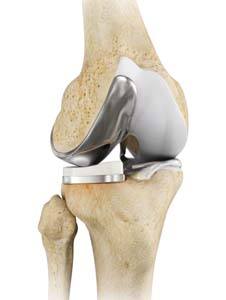
Unicompartmental/Partial Knee Replacement Surgeon in Raleigh, Garner, Cary, NC.
People with osteoarthritis that is confined to a single compartment of the knee are candidates for unicompartmental knee replacement, in which only the damaged compartment of the knee is replaced with an implant. Dr. McNabb provides diagnosis and unicompartmental knee replacement in Raleigh, Garner, Cary, NC. Dr. McNabb also provides the highest level of care during and after the surgery. Contact Dr. McNabb's office for an appointment today!

What is Unicompartmental Knee Replacement?
Unicompartmental knee replacement is a surgery in which only the damaged compartment of the knee is replaced with an implant. It is also called a partial knee replacement.
The knee can be divided into three compartments: patellofemoral, the compartment in front of the knee between the kneecap and thighbone, the medial compartment, on the inside portion of the knee, and lateral compartment which is the area on the outside portion of the knee joint.
Disease Overview of Arthritis
Arthritis is the inflammation of a joint that causes pain, swelling (inflammation) and stiffness.
Osteoarthritis is the most common form of knee arthritis, in which the joint cartilage gradually wears away. In a normal joint, articular cartilage allows for smooth movement within the joint, whereas in an arthritic knee the cartilage itself becomes thinner or completely absent. In addition, the bones become thicker around the edges of the joint and may form bony spurs. These factors can cause pain and restricted range of motion in the joint.
Diagnosis of Arthritis
Dr. McNabb will diagnose osteoarthritis based on your medical history, physical examination, and X-rays. X-rays typically show a narrowing of joint space in the arthritic knee and in advanced stages “bone-on-bone”.
Treatment for Arthritis
There are many treatments indicated for arthritis – both conservative and surgical. Dr. McNabb will discuss the best option depending on your individual condition.
Indications of Unicompartmental Knee Replacement
Traditionally, total knee replacement was commonly indicated for severe osteoarthritis of the knee. In total knee replacement, all worn out or damaged surfaces of the knee joint are removed and replaced with new artificial parts. Partial knee replacement is a surgical option if your arthritis is confined to a single compartment of your knee. Dr. McNabb will thoroughly discuss with you the indications of a partial versus total knee replacement.
Surgical Procedure of Unicompartmental Knee Replacement
During the surgery, an incision is made over the knee to expose the knee joint. As with a total knee replacement, the ends of the bones are replaced with metal caps and a plastic component is placed in between. The muscles and tendons are then repaired and the incision is closed.
Postoperative Care Following Unicompartmental Knee Replacement
You may walk with the help of a walker for the first 1-2 weeks after surgery and then transition to a cane. A physical therapist will introduce you to an exercise program to follow for 4 to 6 months to help maintain range of motion and restore your strength. You may perform exercises such as walking, swimming, and biking but high impact activities such as jogging should be avoided.
Risks and Complications Following Surgery for Unicompartmental Knee Replacement
The possible risks and complications associated with unicompartmental knee replacement include:
- Knee stiffness
- Infection
- Blood clots (Deep vein thrombosis)
- Nerve and blood vessel damage
- Ligament injuries
- Patella (kneecap) dislocation
- Wearing of the plastic liner
- Loosening of the implant
If you would like to have additional information on the treatment of various knee conditions or would like to learn more about unicompartmental/partial knee replacement, please contact Dr. McNabb, serving the communities of Raleigh, Garner, Cary, NC.






